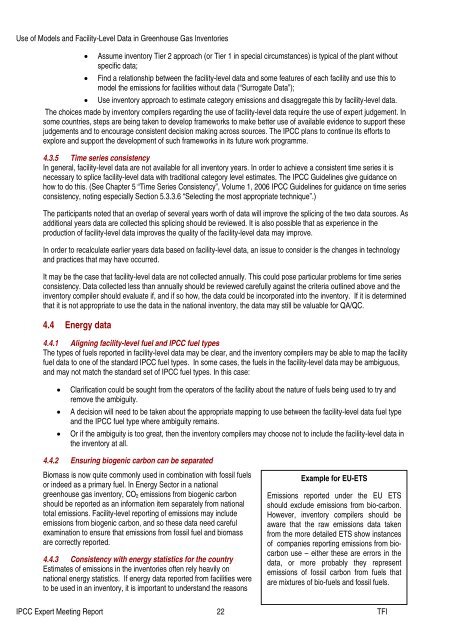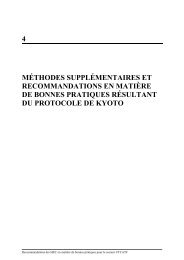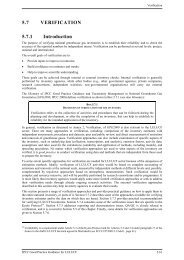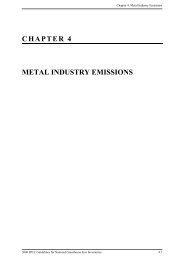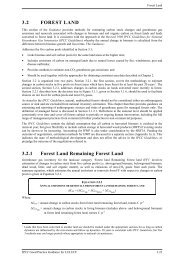Use of Models and Facility-Level Data in Greenhouse Gas Inventories
Use of Models and Facility-Level Data in Greenhouse Gas Inventories
Use of Models and Facility-Level Data in Greenhouse Gas Inventories
You also want an ePaper? Increase the reach of your titles
YUMPU automatically turns print PDFs into web optimized ePapers that Google loves.
<strong>Use</strong> <strong>of</strong> <strong>Models</strong> <strong>and</strong> <strong>Facility</strong>-<strong>Level</strong> <strong>Data</strong> <strong>in</strong> <strong>Greenhouse</strong> <strong>Gas</strong> <strong>Inventories</strong><br />
• Assume <strong>in</strong>ventory Tier 2 approach (or Tier 1 <strong>in</strong> special circumstances) is typical <strong>of</strong> the plant without<br />
specific data;<br />
• F<strong>in</strong>d a relationship between the facility-level data <strong>and</strong> some features <strong>of</strong> each facility <strong>and</strong> use this to<br />
model the emissions for facilities without data (“Surrogate <strong>Data</strong>”);<br />
• <strong>Use</strong> <strong>in</strong>ventory approach to estimate category emissions <strong>and</strong> disaggregate this by facility-level data.<br />
The choices made by <strong>in</strong>ventory compilers regard<strong>in</strong>g the use <strong>of</strong> facility-level data require the use <strong>of</strong> expert judgement. In<br />
some countries, steps are be<strong>in</strong>g taken to develop frameworks to make better use <strong>of</strong> available evidence to support these<br />
judgements <strong>and</strong> to encourage consistent decision mak<strong>in</strong>g across sources. The IPCC plans to cont<strong>in</strong>ue its efforts to<br />
explore <strong>and</strong> support the development <strong>of</strong> such frameworks <strong>in</strong> its future work programme.<br />
4.3.5 Time series consistency<br />
In general, facility-level data are not available for all <strong>in</strong>ventory years. In order to achieve a consistent time series it is<br />
necessary to splice facility-level data with traditional category level estimates. The IPCC Guidel<strong>in</strong>es give guidance on<br />
how to do this. (See Chapter 5 “Time Series Consistency”, Volume 1, 2006 IPCC Guidel<strong>in</strong>es for guidance on time series<br />
consistency, not<strong>in</strong>g especially Section 5.3.3.6 “Select<strong>in</strong>g the most appropriate technique”.)<br />
The participants noted that an overlap <strong>of</strong> several years worth <strong>of</strong> data will improve the splic<strong>in</strong>g <strong>of</strong> the two data sources. As<br />
additional years data are collected this splic<strong>in</strong>g should be reviewed. It is also possible that as experience <strong>in</strong> the<br />
production <strong>of</strong> facility-level data improves the quality <strong>of</strong> the facility-level data may improve.<br />
In order to recalculate earlier years data based on facility-level data, an issue to consider is the changes <strong>in</strong> technology<br />
<strong>and</strong> practices that may have occurred.<br />
It may be the case that facility-level data are not collected annually. This could pose particular problems for time series<br />
consistency. <strong>Data</strong> collected less than annually should be reviewed carefully aga<strong>in</strong>st the criteria outl<strong>in</strong>ed above <strong>and</strong> the<br />
<strong>in</strong>ventory compiler should evaluate if, <strong>and</strong> if so how, the data could be <strong>in</strong>corporated <strong>in</strong>to the <strong>in</strong>ventory. If it is determ<strong>in</strong>ed<br />
that it is not appropriate to use the data <strong>in</strong> the national <strong>in</strong>ventory, the data may still be valuable for QA/QC.<br />
4.4 Energy data<br />
4.4.1 Align<strong>in</strong>g facility-level fuel <strong>and</strong> IPCC fuel types<br />
The types <strong>of</strong> fuels reported <strong>in</strong> facility-level data may be clear, <strong>and</strong> the <strong>in</strong>ventory compilers may be able to map the facility<br />
fuel data to one <strong>of</strong> the st<strong>and</strong>ard IPCC fuel types. In some cases, the fuels <strong>in</strong> the facility-level data may be ambiguous,<br />
<strong>and</strong> may not match the st<strong>and</strong>ard set <strong>of</strong> IPCC fuel types. In this case:<br />
• Clarification could be sought from the operators <strong>of</strong> the facility about the nature <strong>of</strong> fuels be<strong>in</strong>g used to try <strong>and</strong><br />
remove the ambiguity.<br />
• A decision will need to be taken about the appropriate mapp<strong>in</strong>g to use between the facility-level data fuel type<br />
<strong>and</strong> the IPCC fuel type where ambiguity rema<strong>in</strong>s.<br />
• Or if the ambiguity is too great, then the <strong>in</strong>ventory compilers may choose not to <strong>in</strong>clude the facility-level data <strong>in</strong><br />
the <strong>in</strong>ventory at all.<br />
4.4.2 Ensur<strong>in</strong>g biogenic carbon can be separated<br />
Biomass is now quite commonly used <strong>in</strong> comb<strong>in</strong>ation with fossil fuels<br />
or <strong>in</strong>deed as a primary fuel. In Energy Sector <strong>in</strong> a national<br />
greenhouse gas <strong>in</strong>ventory, CO 2 emissions from biogenic carbon<br />
should be reported as an <strong>in</strong>formation item separately from national<br />
total emissions. <strong>Facility</strong>-level report<strong>in</strong>g <strong>of</strong> emissions may <strong>in</strong>clude<br />
emissions from biogenic carbon, <strong>and</strong> so these data need careful<br />
exam<strong>in</strong>ation to ensure that emissions from fossil fuel <strong>and</strong> biomass<br />
are correctly reported.<br />
4.4.3 Consistency with energy statistics for the country<br />
Estimates <strong>of</strong> emissions <strong>in</strong> the <strong>in</strong>ventories <strong>of</strong>ten rely heavily on<br />
national energy statistics. If energy data reported from facilities were<br />
to be used <strong>in</strong> an <strong>in</strong>ventory, it is important to underst<strong>and</strong> the reasons<br />
Example for EU-ETS<br />
Emissions reported under the EU ETS<br />
should exclude emissions from bio-carbon.<br />
However, <strong>in</strong>ventory compilers should be<br />
aware that the raw emissions data taken<br />
from the more detailed ETS show <strong>in</strong>stances<br />
<strong>of</strong> companies report<strong>in</strong>g emissions from biocarbon<br />
use – either these are errors <strong>in</strong> the<br />
data, or more probably they represent<br />
emissions <strong>of</strong> fossil carbon from fuels that<br />
are mixtures <strong>of</strong> bio-fuels <strong>and</strong> fossil fuels.<br />
IPCC Expert Meet<strong>in</strong>g Report 22 TFI


